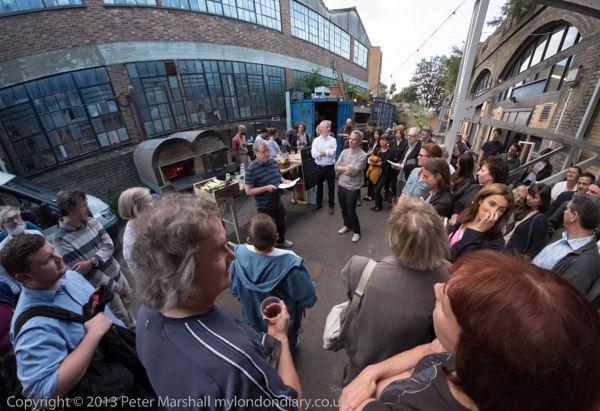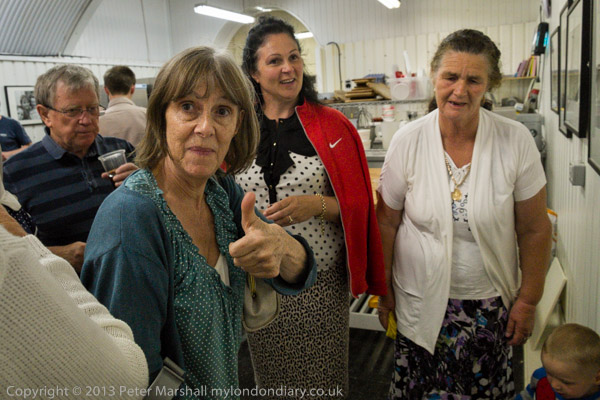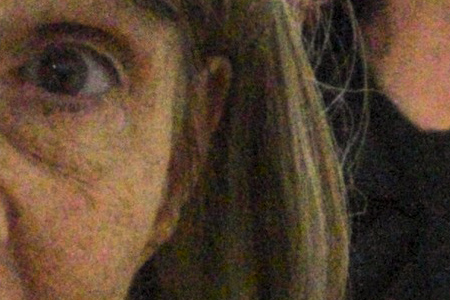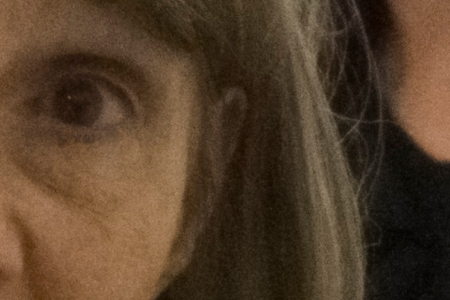It seems a very long time ago that I wrote about the book launch of Colin O’Brien’s Traveller Children, and I’m rather surprised to find it was only 3 weeks ago. I’d just got a new lens for my Fuji X cameras, and had taken taken out the Fuji XE-1 with the Samyang 8mm f2.8 (along with the Fuji 18-55mm) to try out the Samyang.

The people close to the image edge are noticeably less distorted than with the Nikon 10.5mm
Like the 10.5mm Nikon I’ve loved to use, the Samyang is a DX format lens that gives a ‘diagonal fisheye’ view, producing an image that fills the frame with a 180 degree view across the diagonal of the image. Of course I can use the Nikon lens on the Fuji X cameras with a suitable adapter, but the Samyang is smaller, lighter and altogether more convenient to use. It also has a different – though similar – perspective, its ‘stereographic’ projection giving less distortion of objects at the edges of the image. Like the Nikon, it also suffers from a fairly distinct degree of chromatic aberration, which can be largely corrected in Lightroom or other software, but otherwise is optically pretty impressive.
It also, like the Nikon, has a bulbous front element which precludes the normal use of front of the lens filters, but with a lens that cost me around £230 I’m rather less worried than with more expensive glass It fits nicely on the Fuji XE1, and is also available for Sony E and Samsung NX mounts. It comes in both black and silver finish, so of course I choose the black.
The first – and so far only – minor disappointment is that at the back of the black finish lens barrel is a half an inch of shiny silver lens, cosmetically something of a disaster. Apart from this the build quality seems impressive for the price (actually better than many expensive lenses.) This is a manual lens, but this isn’t really a problem. You seldom need to focus an 8mm lens, and with the shutter speed on Auto, the digital viewfinder automatically adjusts (if sometimes just a little slowly) to give a properly adjusted viewfinder image.

With the different projection, software such as my favourite Fisheye-Hemi dpn’t quite work properly, and need a little tweaking in Lightroom to get things more or less right – as in the example above. I was pretty pleased with this lens and look forward to using it more. Some of my favourite images on the Fuji-X cameras to date have been taken with the Nikon 10.5mm, and this looks to be a more convenient replacement. You don’t get any information on aperture or distance setting in the Exif data, but the scales on the lens are very clear and seem accurate.
What I didn’t say in the previous piece was that all of the images at the book launch, including the exterior images such as these were taken at ISO 6400, a full stop faster than I usually like to work, even with the Nikon D800E. I’d set the camera at this speed inside the gallery space, where the light was rather dim, and simply forgot to alter it when I came outside.

I can’t pretend the quality is the same as it would have been at say ISO 400, but it is surprisingly good and usable for many purposes. Of course it isn’t just the camera, but also the noise reduction from Lightroom. Here’s a 1:1 crop from a part of the image without any noise reduction:

and here is the more or less the same area of the image, again 1:1, after some fairly aggressive noise reduction and a little sharpening:

I probably haven’t got the settings at the optimum, but the difference is clear, with virtually all the colour noise (and some colour) removed, along with much of the luminance noice. Very little actual detail seems to have been lost, and although at full size it seems a little low in contrast and lacking in colour, it works pretty well at web scale, and also for reasonable size prints. And the contrast and saturation could easily be increased if necessary.
The result of the high levels of noise removal can be seen in the upper images, in particular the second image down, where the foreground figures somehow seem too smooth and lacking in detail. But digital is certainly producing results that would have been impossible with film.
________________________________________________________
My London Diary : Buildings of London : River Lea/Lee Valley : London’s Industrial Heritage
All photographs on this and my other sites, unless otherwise stated are by Peter Marshall and are available for reproduction or can be bought as prints.
To order prints or reproduce images
________________________________________________________